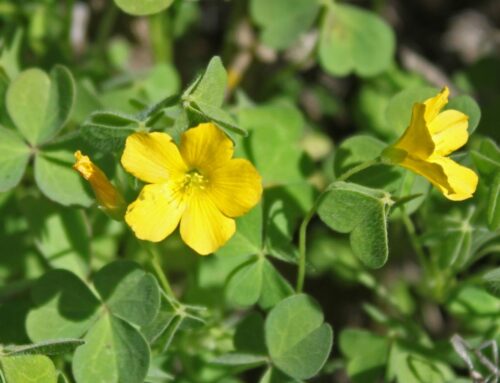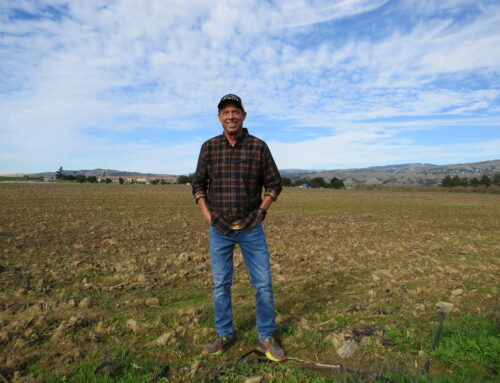The 348-acre wildnerness north of MH open every day from 7 a.m. to sunset
Published in the July 8-21, 2015 issue of Morgan Hill Life
By Staff Report

Photo by Marty Cheek
Attendees cut a ribbon to celebrate the opening of the Open Space Authority’s Coyote Valley Open Space Preserve, the South Valley region’s newest recreational wilderness area Saturday, June 27.
The public celebrated the opening of the Open Space Authority’s Coyote Valley Open Space Preserve, the South Valley region’s newest recreational wilderness area Saturday, June 27.
The 348-acre preserve is located a few miles north of Morgan Hill on the western edge of Coyote Valley, which lies in the 7,400 acre valley floor and greenbelt between San Jose and Morgan Hill. The land for decades was eyed for corporate campuses, tract homes and other commercial development. In 2010, the economic downturn allowed the OSA to purchase the land for nearly $3.5 million.
With the June 27 celebration, the preserve is open every day of the year from 7 a.m. to sunset free of charge. It is the third public preserve opened by the OSA in Santa Clara County.
“The Open Space Authority makes sure our region balances growth by preserving open space and parks and agricultural lands and natural areas, places like the Coyote Valley,” said Andrea Mackenzie, general manager of the OSA. “In short, this valley defines sense of place. It’ll be place for current and future generations to enjoy unique opportunities for healthy outdoor recreation and a place for retreat and reflection in one of the fastest growing areas of California.”
Mike Potter, chair of the OSA’s board of directors, said the public opening of the Coyote Valley Preserve was made possible through the passage of Measure Q, the parcel tax that raises funds for the OSA which passed in November 2014.
“This is a stage of a relay race,” he said. “Open space acquisition and the opening of this preserve is an important milestone for our community and our region, while at the same time we’re connecting people to the land and all the benefits of fresh air and outdoor exercise and the appreciation of nature.”
California State Senator Jim Beale described how in the 1960s developers came up with a proposal for the South Valley to build a 125,000 home community around Lake Anderson.
“There were many battles going on in the 1970s and 1980s and 1990s to fully develop the valley,” he said. “That resulted in the actions by local citizens to create the Open Space District and create the funding for the Open Space District. So the people have spoken. They want this area preserved. This (preserve) is the mandate that the people of Santa Clara County desire to have this (valley) protected.”
The OSA has identified the Coyote Valley as one of the top 10 priority natural landscapes remaining in Santa Clara County that are critically important to protect from development, Mackenzie said. The preserve’s many conservation values include rich cultural history, valuable water resource, exceptional recreational opportunities, farm and ranch land and a critical wildlife corridor.
The land encompasses rolling hills, oak woodland, serpentine rock outcroppings, and remnant native grasslands. In the spring months, sweeping blankets of wildflowers cover the landscape.
Recreation amenities include a multi-use trail for hikers, cyclists, and equestrians. The four-mile long Arrowhead Loop Trail leads to a ridge top with views of Mount Hamilton, Mount Umunhum and the entire Coyote Valley.
OSA staff have removed dilapidated structures, constructed six sturdy redwood bridges and built a scenic trail, parking area, picnic areas and restroom for public use.
Visitors can learn about the preserve’s wildlife, cultural resources and water resources through a series of educational panels.
The Coyote Valley Preserve provides a critical wildlife corridor and habitat for are rare animal and plant species, including the Bay checkerspot butterfly, Opler’s longhorn moth, golden eagles, Santa Clara Valley dudleya, smooth lessingia, and the jewelflower. Cattle grazing enhances critical habitat for the Bay checkerspot butterfly and other species by reducing invasive plants.
Coyote Valley is also a destination for avid birders, providing a home to a wide array of raptors such as golden eagles and red-tailed and other hawk species, as well as circling turkey vultures.
The preserve provides a key connection for wildlife seeking to traverse the valley from the Santa Cruz Mountains to the Diablo Range, Mackenzie said. One of the OSA’s goals is to connect remaining native habitats and maintain corridors that let animals move between patches of habitat in pursuit of resources.




